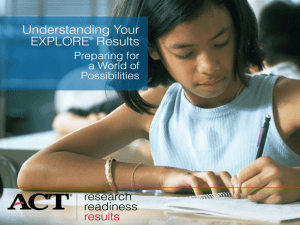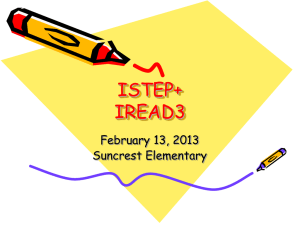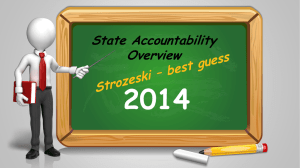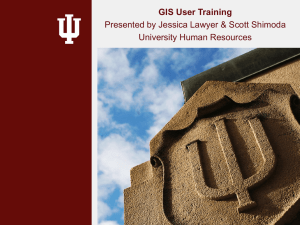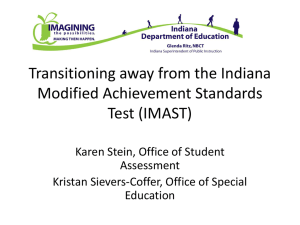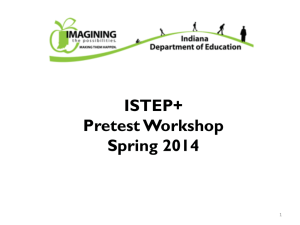the state of mathematics education in indiana
advertisement
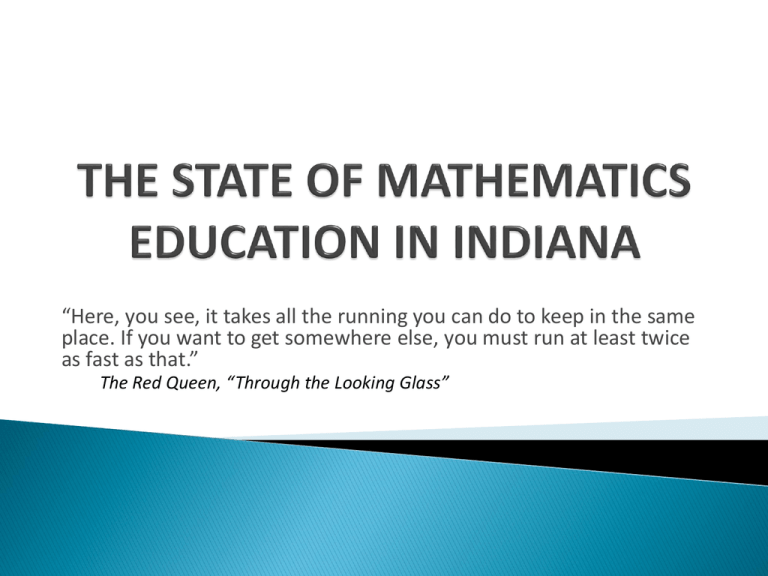
“Here, you see, it takes all the running you can do to keep in the same place. If you want to get somewhere else, you must run at least twice as fast as that.” The Red Queen, “Through the Looking Glass” 2 3 4 Data and Graphics contributed CEEP and IU-SMAP This takes into account students’ race/ethnicity, gender, socioeconomic status, eighth grade achievement levels, high school behavior, parenting variables, and psychological variables. Source: Measuring Up 2006. Regular Core 40 Academic Honors 4 credits (2 years) 6 credits (3 years) 8 credits (4 years) Algebra I and any other course Algebra I, Geometry, and Algebra II Algebra I, Geometry, Algebra II, and any other course • The Class of 2011 and beyond must complete, at the minimum, the Core 40 diploma. 8 • The percentage of regular diplomas granted has decreased 31.2 points from the 1997-98 to 200809 school years. Diplomas Granted to Public School Students 100% 90% 80% 70% •In this same time frame, the percentages of Honors and Core 40 diplomas granted have increased 11.8 and 19.3 percentage points, respectively. 60% 50% 40% 30% 20% 10% 0% International Baccalaureate Diploma Honors Grads Core 40 Only Regular Grads 9 Prior to the Class of 2012, students had to pass the GQE (Grade 10 ISTEP+) in order to graduate high school With the Class of 2012 and beyond, students must pass End-of-Course Assessments (ECAs) in both Algebra I and English 10 10 In 2003, the average scale score for Indiana was 3% higher than the US average and 8% higher than the international average for Grade 4 For Grade 8, Indiana was 1% higher than the US average scale score and 9% higher than the international average scale score Source: “Indiana’s Math and Science Performance: Do We Measure Up?” Rosanne Chien, et al., Fall 2007 http://ceep.indiana.edu/projects/PD F/PB_V5N7_Fall_2007_EPB.pdf 11 Indiana did not participate separately in the 2007 TIMSS The average scale score for the United States was 12% and 10% higher than the international average for Grade 4 and Grade 8, respectively Top 10 Countries in Grade 4 Mathematics Performance, 2007 Top Ten Top 10 Countries in Grade 8 Mathematics Performance, 2007 Country Average Scale Score Country Average Scale Score Hong Kong SAR 607 Chinese Taipei 598 Singapore 599 Rep. of Korea 597 Chinese Taipei 576 Singapore 593 Japan 568 Hong Kong SAR 572 Kazakhstan 549 Japan 570 Russian Federation 544 Hungary 517 England 541 England 513 Latvia 537 Russian Federation 512 Netherlands 535 United States 508 Lithuania 530 Lithuania 506 United States 529 International Average 460 International Average 473 12 The National Assessment of Educational Progress (NAEP) • Also known as The Nation’s Report Card, NAEP collects data from representative samples of students from grades 4, 8 and 12 and in all 50 states in a variety of subjects • NAEP is the only uniform and continuous assessment of America’s students • In addition to standard scale scores, NAEP identifies the percentages of students in four proficiency categories: Below Basic, Basic, Proficient, and Advanced 13 Student Performance on NAEP: Grade 4 Mathematics NAEP Grade 4 Average Scale Mathematics Scores Indiana has performed above the national average, between 2000 and 2007, Indiana’s average scale score increased 5.2% while the nation’s improved 6.7% The next round should be watched closely to see if the 07 – 09 decrease becomes a trend or was an aberration. 249 245 243 244 240 Scale Score 239 234 239 238 240 237 233 234 229 224 224 219 2000 2003 2005 Year Indiana Nation 2007 2009 14 14 4th-grade NAEP Mathematics Race/Ethnicity Gaps 220 20 227 25 232 26 208 202 208 32 34 34 188 193 1990 1992 246 248 248 21 20 21 21 222 226 227 227 234 24 200 243 31 27 26 26 26 198 203 216 220 222 222 1996 2000 2003 2005 2007 2009 White Hispanic Black NAEP Grade 8 Average Scale Mathematics Scores 300 295 The nation has seen a 4.0% increase in its average scale score from 2000 to 2009, compared to Indiana’s 2.1% increase in the same period Scale Score 290 287 285 285 281 281 280 283 282 280 278 276 275 272 270 2000 2003 2005 2007 2009 Year Indiana Nation 16 8th-grade NAEP Mathematics Race/Ethnicity Gaps 270 24 246 281 277 249 28 251 40 36 266 32 31 34 27 265 262 259 253 26 27 29 31 30 293 291 289 288 284 33 40 237 237 240 244 252 255 260 261 1990 1992 1996 2000 2003 2005 2007 2009 41 White Hispanic Black Student Performance on ISTEP+ • The percentage of students passing the mathematics portion of ISTEP+ has increased across Grades 3, 6, 8, and 10 since the 1997-98 school year Student Performance on the Mathematics Portion of ISTEP+ 85 80 75 70 Grade 3 65 Grade 6 Grade 8 60 Grade 10 55 50 School Year 18 18 Grade 3 Grade 8 20 20 18 16 14 14 12 12 10 8 18 18 9 15 13 11 13 15 14 10 7 6 5 4 8 2 0 0 2006 2007 2008 2009 White-Black Gap (Blue) 20 18 16 15 15 8 6 13 8 7 6 14 12 15 10 4 2 2005 20 12 11 10 6 26 23 14 8 26 25 16 11 28 18 14 12 10 30 19 16 12 8 19 Grade 10 5 0 2005 2006 2007 2008 White-Hispanic Gap (Red) 2009 2005 2006 2007 2008 2009 Paid Lunch-Free/Reduced Gap (Yellow) • Grade 3 mathematics achievement gaps all widened between 2006 and 2008, but decreased in 2009 • Grade 8 achievement gaps decreased between 2006 and 2008, but widened in 2009 •Grade 10 achievement gaps decreased from 2005 to 2007, but widened in 2008 19 Indiana State Averages Algebra I End-of-Course Assessment Year 2005-2006 2006-2007 2007-2008 2008-2009 # of students tested Average scale score % passing Middle School % passing High School % passing Total 73,587 510 NA NA 24% 78,429 517 59% 18% 29% 87,219 527 69% 21% 34% 97,388 524 70% 31% 41% 20 College Math Remediation in Indiana Table 1. First-Year Students in Indiana Public Higher Education Institutions Taking Remedial Coursework Number of first-year students % taking remedial Mathematics % taking % taking remedial remedial Language Arts Mathematics and Language Arts 2004-05 105,863 27.5 11.9 8.9 2005-06 110,711 26.5 11.5 8.0 2006-07 111,126 27.9 11.0 8.5 21 Recommendations in six key areas: College Completion Affordability Preparation Community College Major Research Universities Accountability Source: http://www.in.gov/che/2349.htm Define a common college readiness assessment and passing score range that will be used consistently to determine if a student is ready to start credit-bearing, college-level coursework. This common metric should be determined collaboratively between higher education and K-12 and also should be used to identify student remedial needs. Work with the Indiana State Board of Education to implement an aligned system of voluntary college readiness tools that students may take advantage of at key points during their K-12 years. These assessments should provide students and teachers with understandable and dependable signals of whether or not a student is on track to meet the common metric for college readiness (i.e., ACT tools — EXPLORE, PLAN, ACT; College Board tools — new 8th grade assessment, PSAT, SAT; CSU Early Assessment Program; etc.). Communicate information from these college readiness assessments in ways that provide schools, teachers, students and families with a clear understanding of where the students are in terms of their academic progression. Information should be timely to allow students to use the junior and/or senior year to correct any academic deficiencies while in high school rather than taking remedial coursework in college. Indiana has traditionally been a stronger math education state than language education state regarding student outcomes. Although there are many positives to point to, several historic and recent trends are cause for serious concern. ◦ HS students not taking four years of math ◦ Large achievement gaps ◦ Tremendous remediation rates at the college-level Although outcome data are similar to those for students in states such as Florida, the increases in these other states point to much greater rates of positive change. March 2009 – Indiana Adopts new Academic Standards for Mathematics 2009-10 – Year for Instructional Materials Adoption for Math Indiana -- Dana Center provides a process for adoption In March of 2010, school corporations were advised to delay their math textbook adoption. Teachers will NOT teach Math 2009 standards The Common Core State Standards Initiative is a state-led effort coordinated by the National Governors Association Center for Best Practices (NGA Center) and the Council of Chief State School Officers (CCSSO). The standards were developed in collaboration with teachers, school administrators, and experts, to provide a clear and consistent framework to prepare our children for college and the workforce. These standards define the knowledge and skills students should have within their K-12 education careers so that they will graduate high school able to succeed in entrylevel, credit-bearing academic college courses and in workforce training programs. Initially 48 states and three territories signed on to adopt (Which states didn’t?) Final Standards released June 2, 2010, and as of September 15, 2010, all but 13 states officially adopted the Common Core in Math and ELA as the state standards http://www.corestandards.org/ STANDARDS FOR MATHEMATICS JUNE 2010 Standards for Mathematical Practice Carry across all grade levels Describe habits of mind of a mathematically expert student Standards for Mathematical Content K-8 standards presented by grade level Organized into domains that progress over several grades Grade introductions give 2–4 focal points at each grade level High school standards presented by conceptual theme (Number & Quantity, Algebra, Functions, Modeling, Geometry, Statistics & Probability) Content standards define what students should understand and be able to do Clusters are groups of related standards Domains are larger groups that progress across grades Grade Level Overviews Focal points at each grade level Graded ramp up to Algebra in Grade 8 Properties of operations, similarity, ratio and proportional relationships, rational number system. Focus on linear equations and functions in Grade 8 Expressions and Equations ◦ Work with radicals and integer exponents. ◦ Understand the connections between proportional relationships, lines, and linear equations. ◦ Analyze and solve linear equations and pairs of simultaneous linear equations. Functions ◦ Define, evaluate, and compare functions. ◦ Use functions to model relationships between quantities. Conceptual themes in high school Number and Quantity Algebra Functions Modeling Geometry Statistics and Probability College and career readiness threshold (+) standards indicate material beyond the threshold; can be in courses required for all students. Middle school foundations Hands-on experience with transformations. Low tech (transparencies) or high tech (dynamic geometry software). High school rigor and applications Properties of rotations, reflections, translations, and dilations are assumed, proofs start from there. Connections with algebra and modeling Focus and coherence • • Focus on key topics at each grade level. Coherent progressions across grade levels. Balance of concepts and skills • Content standards require both conceptual understanding and procedural fluency. Mathematical practices • Foster reasoning and sense-making in mathematics. College and career readiness • Level is ambitious but achievable. The promise of standards These Standards are not intended to be new names for old ways of doing business. They are a call to take the next step. It is time for states to work together to build on lessons learned from two decades of standards based reforms. It is time to recognize that standards are not just promises to our children, but promises we intend to keep. 1. 2. 3. 4. 5. 6. 7. 8. Make sense of problems and persevere in solving them. Reason abstractly and quantitatively. Construct viable arguments and critique the reasoning of others. Model with mathematics. Use appropriate tools strategically. Attend to precision. Look for and make use of structure. Look for and express regularity in repeated reasoning. High School K-8 Conceptual Category Grade Domain Domain Cluster Cluster Standards Standards (No pre-K Common Core Standards) Traditional v Integrated HS Pathways Teachers will teach Math 2000 standards Teachers will NOT teach Math 2009 standards For ISTEP+ Math 2000 standards will be tested Math Teachers will teach English/language arts 2006 standards For ISTEP+ English/ language arts 2006 standards will be tested English English Math Teachers will teach Math 2000 standards Teachers will also teach Common Core standards For ISTEP+ Math 2000 standards will be tested For selected schools, Common Core test items will be piloted Teachers will teach English/language arts 2006 standards Teachers will also teach Common Core standards For ISTEP+ English/language arts 2006 standards will be tested For selected schools, Common Core test items will be piloted Teachers will teach Math 2000 and Common Core standards For ISTEP+ Math 2000 and Common Core standards will be tested Math Teachers will teach English/language arts 2006 and Common Core standards For ISTEP+ English/ language arts IN 2006 and Common Core standards will be tested English We anticipate a multi-state test on the Common Core State Standards. We expect this test will be given over the course of the year , so results can be acted upon, with the final section at the end of the year. We expect this assessment will be given online, with paper and pencil testing only used as an accommodation. The I-STEM Resource Network is a partnership of Indiana’s higher education institutions, K-12 schools, business, and government. ◦ Eighteen Institutions of Higher Education from 10 geographic areas form the framework for the network I-STEM works to support K–12 teachers and leaders working to implement high academic standards towards STEM literacy for all students. Algebra Readiness Initiative ◦ For teachers and administrators to prepare students for success in algebra ◦ Conference and workshops on cognitive demand, algebraic habits of mind, and formative assessment Middle Level Mathematics Courses ◦ Provide teachers with content and instructional skills to prepare students for rigorous mathematics courses Algebra and Functions Geometry and Measurement Data Analysis and Probability Number Sense and Operations Mathematics Curricular Materials Adoption Strategic Plan for Mathematics Education in Indiana Adding to the challenge of preparing our workforce, businesses have higher expectations of their employees 47 Today’s youth—connected to iPods, game systems and cell phones—often wear more technology than some adults will use in a day. They have global connections through MySpace and Facebook, know computer programs to mix music and make movies, and are fluent in the language of text messaging. However, despite their advanced abilities, these children often spend their days disengaged and disinterested in today’s traditional high school classrooms. PBL vs. DOING PROJECTS Traditional Instruction: Large activities completed after the students have been pushed through homework assignments, lectures, and readings. Usually a culminating event for a unit or semester. Practice Problems Lecture Class discussion Lecture Culminating Project Textbook Activity Textbook Activity Practice Problems 49 PBL vs. DOING PROJECTS PBL: Students are pulled through the curriculum by a driving question or realistic problem that provides a “need to know”. Lectures, readings, and skill building are integrated into the problem as the students need the information. Practice Problems Lecture Driving Question Interview Textbook Activity Class Discussion Lecture Practice Problems Results Evaluation 50 An initiative to introduce project-based learning (PBL) techniques to mathematics teachers by partnering with local businesses to develop and to deliver projects that instruct students in core math standards. Math Matters provides PBL instruction, structure, and on-going support for math teachers in southeastern Indiana. Program goal: To help teachers improve student achievement in math through rigorous, authentic projects that prepare students for the demands of the twenty-first century. 51 51 The ‘Math Matters’ Model ─ basic tenets • A regional community of PBL-experienced math educators can be built one teacher at a time • PBL can be introduced and prosper in a traditional math classroom • Math teachers can utilize PBL at the pace that works for them • Administration understanding and support of PBL is required for it to succeed • Local community partnerships strengthen PBL by providing a real and immediate context for projects and building the mutually beneficial bond between the classroom and community • Developing a dynamic and readily available electronic library of standards-based math projects is key to growing PBL regionally and beyond • On-going local support from experienced PBL educators is necessary for our ‘grass roots’ PBL model to succeed and prosper 52 53 Math Matters ─ by the numbers 2009 Number of projects developed . . . . . . . . . 54 2010 Participants (K through post-secondary) . . . . . . . 71 % of elementary teachers . . . . . . . . 54% Number of returnees from 2009 . . . . . . .12 Number of teacher partnerships . . . . . . . 20 Number teachers earning grad credit . . . . . 10 Number of projects developed . . . . . . . . 44 When someone tells you that ‘Oh, math is not really my thing,’ respond back, ‘and working at McDonald’s isn’t mine.’” ◦ Danny Crichton, Stanford University Student
